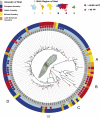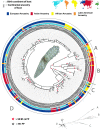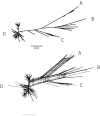Global divergence of the human follicle mite Demodex folliculorum: Persistent associations between host ancestry and mite lineages
- PMID: 26668374
- PMCID: PMC4703014
- DOI: 10.1073/pnas.1512609112
Global divergence of the human follicle mite Demodex folliculorum: Persistent associations between host ancestry and mite lineages
Abstract
Microscopic mites of the genus Demodex live within the hair follicles of mammals and are ubiquitous symbionts of humans, but little molecular work has been done to understand their genetic diversity or transmission. Here we sampled mite DNA from 70 human hosts of diverse geographic ancestries and analyzed 241 sequences from the mitochondrial genome of the species Demodex folliculorum. Phylogenetic analyses recovered multiple deep lineages including a globally distributed lineage common among hosts of European ancestry and three lineages that primarily include hosts of Asian, African, and Latin American ancestry. To a great extent, the ancestral geography of hosts predicted the lineages of mites found on them; 27% of the total molecular variance segregated according to the regional ancestries of hosts. We found that D. folliculorum populations are stable on an individual over the course of years and that some Asian and African American hosts maintain specific mite lineages over the course of years or generations outside their geographic region of birth or ancestry. D. folliculorum haplotypes were much more likely to be shared within families and between spouses than between unrelated individuals, indicating that transmission requires close contact. Dating analyses indicated that D. folliculorum origins may predate modern humans. Overall, D. folliculorum evolution reflects ancient human population divergences, is consistent with an out-of-Africa dispersal hypothesis, and presents an excellent model system for further understanding the history of human movement.
Keywords: Demodex; coevolution; phylogeography; symbiosis.
Conflict of interest statement
The authors declare no conflict of interest.
Figures





References
-
- Ashford RW. Parasites as indicators of human biology and evolution. J Med Microbiol. 2000;49(9):771–772. - PubMed
-
- Falush D, et al. Traces of human migrations in Helicobacter pylori populations. Science. 2003;299(5612):1582–1585. - PubMed
-
- Kittler R, Kayser M, Stoneking M. Molecular evolution of Pediculus humanus and the origin of clothing. Curr Biol. 2003;13(16):1414–1417. - PubMed
Publication types
MeSH terms
Substances
Associated data
- Actions
- Actions
Grants and funding
LinkOut - more resources
Full Text Sources
Other Literature Sources

